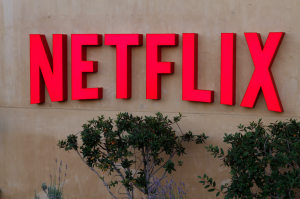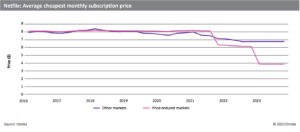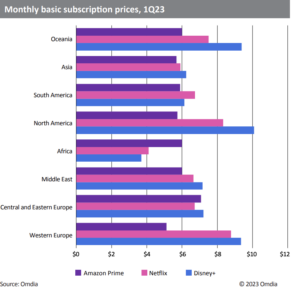
After more than 40 years of operation, DTVE is closing its doors and our website will no longer be updated daily. Thank you for all of your support.
Inside Netflix’s developing markets pricing strategy

Netflix reduced its prices in 1Q23 in many emerging markets worldwide, at the same time as the company opted to increase prices and introduce revenue-raising measures such as paid-sharing in markets like the US.
The defining characteristic of the markets where it opted for price reductions was a lack of local currency billing.
Customers who earn their income in Ghanaian cedi or Malaysian ringgits but pay for Netflix in US dollars have seen substantial price increases as the greenback has risen in value in response to fears of a global economic crisis in 2023.
Step in Netflix’s strategy
However, these changes do not simply represent a reversal of increases through currency fluctuations – they are another step in Netflix’s strategy of moving away from a single subscription model worldwide toward a model with more local content, more local package options, and more sophisticated local pricing.
 Netflix’s price reductions were proportionally the largest in markets in Sub-Saharan Africa, where the effective price of a standard monthly subscription fell by almost 50%. In many cases, these price reductions resolved two anomalies. First, by reducing the average price of the cheapest Netflix subscription in these markets, prices in poorer emerging markets are now substantially lower than in Netflix’s other markets. Previously, the average price paid by consumers in poorer countries was often much higher than in more economically developed nations.
Netflix’s price reductions were proportionally the largest in markets in Sub-Saharan Africa, where the effective price of a standard monthly subscription fell by almost 50%. In many cases, these price reductions resolved two anomalies. First, by reducing the average price of the cheapest Netflix subscription in these markets, prices in poorer emerging markets are now substantially lower than in Netflix’s other markets. Previously, the average price paid by consumers in poorer countries was often much higher than in more economically developed nations.
The second anomaly Netflix resolved was the large gap between pricing within regions based on billing currency. For example, prices paid in Bolivia and Libya were almost double those in Argentina or Egypt.
Netflix’s global price reductions still left the cost of basic subscriptions substantially higher than in its priority developing markets such as Turkey and India, where prices were $2.04 and $2.42 a month, respectively. While the US giant’s balance sheet and expenditures remain in US dollars, there is a natural reluctance to embrace local currency billing fully.
 As the longstanding war for viewers rages, Netflix’s pricing reduction strategy brings its pricing in line with that of basic Disney+ and Amazon Prime subscriptions in most regions. The streaming giant has made it clear that quality programming is not enough of a hook on its own and that it needs to compete with its richer rivals on the basis of price as well.
As the longstanding war for viewers rages, Netflix’s pricing reduction strategy brings its pricing in line with that of basic Disney+ and Amazon Prime subscriptions in most regions. The streaming giant has made it clear that quality programming is not enough of a hook on its own and that it needs to compete with its richer rivals on the basis of price as well.
India has become the sandbox for streaming companies’ strategy changes, and here Netflix’s use of a mobile tier and price cuts have seen the company achieve greater success than in other markets—although less than rivals Amazon Prime or Disney+ Hotstar.
While the pandemic saw a sharp acceleration in streaming viewers and viewership in many of Netflix’s more mature markets, this effect was much more limited across the developing world, where lockdowns were generally shorter and less severe and high-speed home internet is generally lacking. Whereas in 2016, these developing markets had made up around 8.3% of Netflix’s total subscribers, they accounted for just 5.5% in 2022 and a falling share of revenue post-pandemic. Netflix needs a new strategy to hook viewers in these markets where households and online video subscriptions are likely to grow much faster than the global average over the next 10 years.
Netflix with ads
Netflix is currently trialing a number of strategies across different markets to propel subscriber growth and deliver sustainable revenue. The company had tried free Netflix plans in Kenya and Vietnam, but these have since been abandoned. Another solution Netflix is trying in a limited number of mature markets is the Netflix with ads plan. Still, it will be tricky for Netflix to implement this programme in developing countries, where the average online video advertising revenue per household remains low.
Netflix’s ad business is still nascent, and it is unlikely that profitable ad tiers are coming to developing markets in the short term. Another revenue-generating scheme Netflix is trying is the “paid sharing” system, where users pay less than the price of an additional subscription to share their login details with other users who are not in the same household. However, this model will be tricky to implement in developing markets for several reasons. The first challenge is technological, with the current Wi-Fi login-based system of identifying which users are sharing proving problematic in markets where the primary data connection is mobile rather than Wi-Fi based. The evidence from Peru, one of Netflix’s key testing markets for the paid sharing policy, suggested that there ultimately was no satisfactory technical solution to these issues, with support staff essentially recommending to wave through complaints to avoid churn.
Primary device
Clamping down on sharing could limit the company’s growth potential in the markets it hopes will be engines of growth through this decade. In developing markets, if your primary device is a mobile phone, the additional quality of UHD is more limited, and the cost of using more mobile data may be substantial. In addition, Netflix cannot produce local content in all developing markets, so building the business while remaining uncompetitive on price is always likely to be a hard sell.
Netflix has pointed out that markets such as the UK or the US, only around 10% of total viewing time is spent on streaming, while for markets like Poland, Brazil, and Mexico, the number is around 5–6%. For markets such as Thailand, where the company reduced prices in 1Q23, streaming will take a long time to reach the levels of market penetration that it has in the US and Europe.
In the intervening period, maintaining market share will be paramount to eventually driving profitability and subscriber numbers from emerging markets. In this sense, Netflix can effectively afford to reduce costs in developing markets, where revenue is already low, in the hope of maintaining market share and eventually cashing in when the streaming infrastructure catches up.
This article is taken from Omdia’s report Netflix’s 2023 Price Reductions.
Daoud Jackson is senior analyst, media and entertainment at Omdia.


